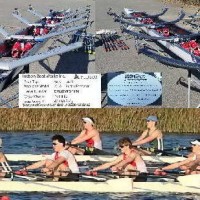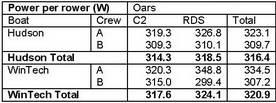Biomechanical evaluation of boats and oars

“Which boats and
which oars are faster?” Questions like this are very often asked by rowers and
coaches in an attempt to improve the performance of their crews. Usually the
differences are very small and simple trials cannot reveal them, because much
more significant effects of rowing power variation and weather conditions hide
them. The power factor could be controlled with instrumentation, and an indoor
tank could be used to avoid the weather factor (RBN 2015/04). An alternative
method is side-by-side trials, where the wind conditions are the same for both
boats.
Two mid-weight
quads: a Hudson Super Predator – 2016 for 75-88kg and WinTech Cobra – 2015 for
80-90kg, both with bow mounted wing riggers, were equipped with BioRowTel
systems, which measured oar angles, handle force, seat movement, boat speed, hull
accelerations and 3D rotations. Two sets of sculls were instrumented and used:
WinTech RDS and Concept2 normal shaft, both with the “Smoothie” blade shape of the
same area.

Two junior male crews
rowed these boats: A crew (average
height 1.86m, weigh 81kg), and B
crew (1.88m, 78kg). Four 1000m full-effort trials were performed by these crews
side-by side using all possible combinations of crew-boat- oars:

This method
allows separate evaluation of effects of 1) the boat hull, 2) oars and 3) crew
performance. The weather conditions were good and consistent (+16oC,
cross-tail wind 2-3m/s).

The average boat
speed was 0.88% faster in the WinTech boat than in the Hudson boat, and 0.13%
faster with RDS oars than with C2 oars. Though the stroke rate was very similar
in all trials, measured rowing power was 1.4% higher in the WinTech boat than
in the Hudson, and 1.7% higher with RDS than with C2 oars. This means the WinTech boat and RDS blades were quite comfortable for the rowers.

Gross and Net Drag Factors (DFg and DFn) were calculated using the method described in RBN 2015/04, which was proven to be reliable and valid.

It was found
that Gross DF was 1.45% lower in the WinTech
boat, which equates to a 0.48% faster boat speed at the same rowing power: at
the given 320W power (6m over 2k), the WinTech boat would have a 1.77s advantage
over the Hudson boat. Similar results were obtained using Net DF: 1.46%
lower DFn in the WinTech boat, which gives a 1.68s gain over a 2km
race. Average DFg of the A crew
was 0.65% higher than in B crew,
which adequately reflects the 3.8% heavier average rower’s weight in the A crew (RBN 2007/07).
Measured boat
roll and yaw (RBN 2012/03) were very similar in both boats, but the boat pitch amplitude was 7.3% lower in
the WinTech boat (0.92deg) compare to the Hudson boat (0.99 deg). This fact
was quite surprising, because the shape of Hudson hull looks much “fuller” at
the ends, which should decrease the boat pitching during the stroke cycle.
In spite of
smaller shaft diameter of the RDS oars (24mm at the blade) compared to C2 oars
(34mm), RDS showed a slightly higher average DF. With the WinTech boat,
RDS had lower DF, but in Hudson they had significantly higher DF,
which could be related to rigging specifics. The tail wind during the trials
reduced aerodynamic resistance and may have diminished the advantage of thinner
RDS oar shafts.
With the
BioRowTel system, every oar is calibrated using a dedicated load cell, so we
always obtain information, which may help to answer another common question about
the stiffness of the oar shafts. It is usually thought that thinner oar shafts
are more flexible, but in this experiment, it was found that, on average, RDS oars were 8.1% stiffer than the
standard Concept2 oar shafts.
Acknowledgments: Thanks to OarSport UK for help with equipment and to Maidenhead RC junior boys squad for participation in this experiment.
©2017 Dr. Valery Kleshnev www.biorow.com



